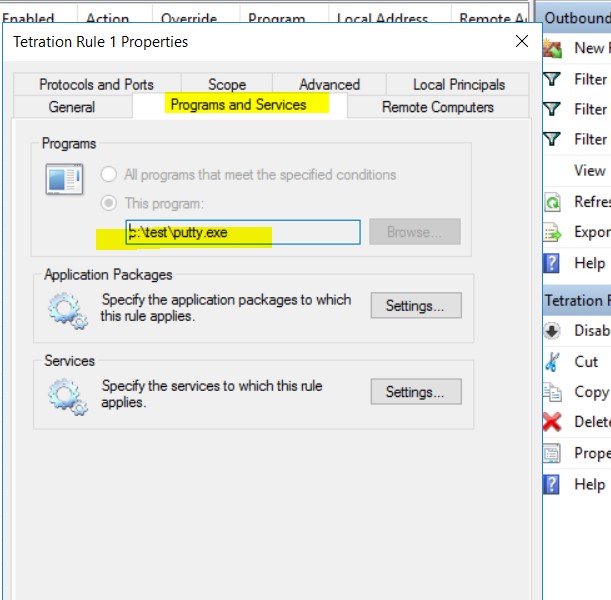Policies Based on Application Name
Use the following information to verify and troubleshoot policies based on application name on Windows OS workloads.
The following sections describe the way policies should appear on the workload for an application binary entered as c:\test\putty.exe.
Sample Policy Based on Application Name
dst_ports {
start_port: 22
end_port: 22
consumer_filters {
application_name: “c:\test\putty.exe”
}
}}
ip_protocol: TCP
address_family: IPv4
inspection_point: EGRESS
Generated Firewall Rule

Generated Filter Using netsh
To verify, using native Windows tools, that a filter has been added to an advanced policy:
-
With administrative privileges, run
cmd.exe. -
Run
netsh wfp show filters. -
The output file, filters.xml, is generated in the current directory.
-
Check FWPM_CONDITION_ALE_APP_ID for the application name in the output file: filters.xml.
<fieldKey>FWPM_CONDITION_ALE_APP_ID</fieldKey>
<matchType>FWP_MATCH_EQUAL</matchType>
<conditionValue>
<type>FWP_BYTE_BLOB_TYPE</type>
<byteBlob>
<data>
˓→5c006400650076006900630065005c0068006100720064006400690073006b0076006f006
˓→</data>
<asString>\device\harddiskvolume2\temp\putty.exe</
˓→asString>
</byteBlob>
</conditionValue>
Generated WFP Filter Using tetenf.exe -l -f
Filter Name: Secure Workload Rule 1
------------------------------------------------------
EffectiveWeight: 18446744073709551592
LayerKey: FWPM_LAYER_ALE_AUTH_CONNECT_V4
Action: Permit
RemoteIP: 10.195.210.15-10.195.210.15
Remote Port: 22
Protocol: 6
AppID: \device\harddiskvolume2\test\putty.exe
Invalid Application Name
-
In WAF mode, Firewall rule is created for an invalid application name.
-
In WFP mode, the WFP filter is not created for an invalid application name but the NPC is not rejected. The agent logs a warning message and configures the rest of the policy rules.
